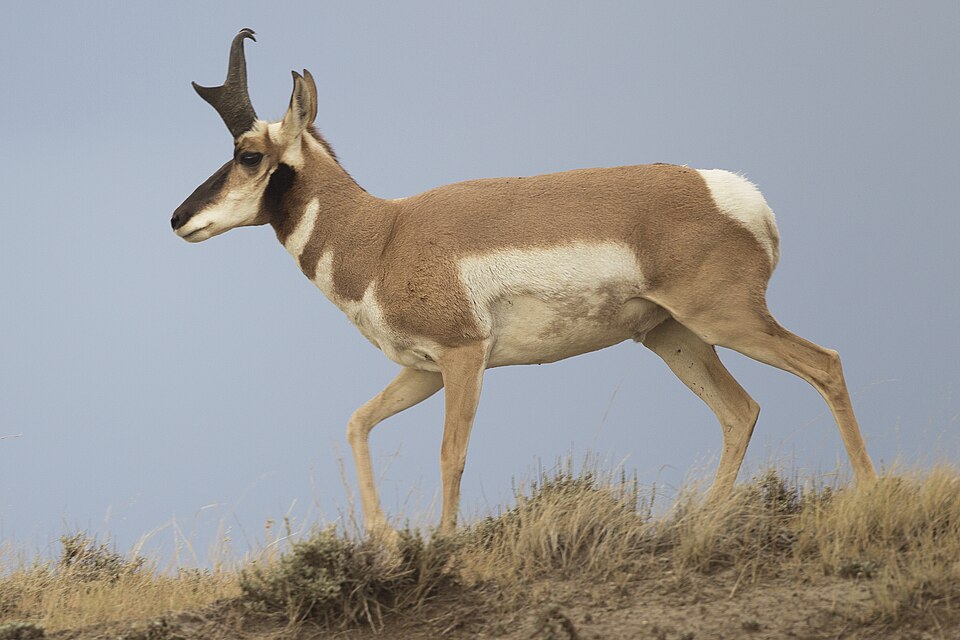
Why is a pronghorn so fast? The pronghorn evolved to have phenomenal speed so that it could outrun predators that no longer exist.
A pronghorn is a hoofed mammal that lives in Western and Central North America. It belongs to the artiodactyl family. This family contains antelopes, hippos, deer, giraffes, camels, and 265 other animals. The pronghorn looks like an antelope, and it is called an American antelope, but it isn’t an antelope. They grow to be about 1 m tall and weigh up to 45 kg. Pronghorns have horns made of bones that grow out from the top of their skull. They have a sheath that grows over this bone and that they shed every year. The sheath grows into a prong at the top, which is where they get their name from. They are herbivores and they eat grasses, sagebrush, and other plants. They are regurgitators, so that they can get all of the nutrition out of the food that they can. They digest it for a while and then regurgitate it into their mouth so they can chew it up again before a second digestion. They are herbivores, so they have eyes on the sides of their head. This gives them a 320 degree field of view, meaning they can spot predators pretty quickly and run away. And this is why we are looking at the pronghorn.
The pronghorn is the fastest land animal in North America and the second fastest land animal with four legs in the world. The ostrich is actually very slightly faster, but it only has two legs, so we are not going to count it. The fastest land animal, of course, is the cheetah. They have a maximum speed of close to 110 km/h, although that is quite difficult to measure. They have ferocious acceleration, but they can’t maintain that speed for more than 30 seconds. They try to get as close to their prey as possible and then use their speed to catch it. The pronghorn can’t run that fast, but it does have a top speed of 88.5 km/h, which it can sustain for about the same 30 seconds as the cheetah, covering about 800 m. However, the longhorn has a level of stamina that the cheetah doesn’t have. The pronghorn can run at 68 km/h for a little over a minute, covering 1.5 km. It can run at 56 km/h for about 7 minutes, covering 6.5 km. That is an incredible mix of speed and endurance.
The question is why are pronghorns so fast? A cheetah needs to be that fast because it is trying to catch animals like gazelles, which are also very fast. The cheetah needs to be faster than its prey. Likewise, a gazelle needs to be fast because the fastest gazelles will probably escape and survive. Evolution would favor the fastest gazelles. In North America, there are no other animals that come anywhere near close to the pronghorn for speed. There is not a single predator that can match it and unless they surprise the pronghorn, there are no predators that could catch one. So, again, why are they so fast?
The obvious answer is that they evolved this speed and this stamina to escape from predators that no longer exist. There used to be a cheetah that lived in North America, called the American cheetah. It went extinct 12,000 years ago, but fossils show that it was probably fast. It was a pursuit animal, similar to the African cheetah and probably reached similar speeds. This would explain why the pronghorn evolved such a fast top speed, but why the stamina? There were also other animals that hunted pronghorn. There were lions, huge jaguars, saber-toothed cats, and long-legged hyenas that were all fast, but not as fast as the cheetah. They couldn’t match the cheetah for speed, but they could run further. The pronghorn evolved the stamina necessary to keep ahead of cats like this and survive. All of these big cats, the predators of the pronghorn, have long gone extinct and there is no reason why pronghorn would start to evolve to be slower. Evolution functions because the animals that survive make it more likely that their genes will be reproduced. If fast animals are more likely to survive, fast genes are more likely to be passed on. With the pronghorn, that hasn’t changed. Slow animals are not more likely to survive, so there is no reason why slow genes would be passed on. If being fast required more food and there was a food shortage, being slow might become an advantage, but that hasn’t happened.
The two main predators of pronghorn at the moment are coyotes, which eat the newborn pronghorns, and humans. We used to hunt them, but now we just destroy their habitat. And this is what I learned today.
Sources
https://wgfd.wyo.gov/wyoming-wildlife/wyoming-wildlife-magazine/american-pronghorn-species-profile
https://en.wikipedia.org/wiki/Pronghorn
https://en.wikipedia.org/wiki/Artiodactyl
https://www.nationalgeographic.com/animals/mammals/facts/pronghorn
https://en.wikipedia.org/wiki/Fastest_animals
Image By Yathin S Krishnappa – Own work, CC BY-SA 3.0, https://commons.wikimedia.org/w/index.php?curid=24551366
